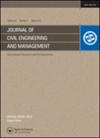BARRIERS TO THE ADOPTION OF NEW SAFETY TECHNOLOGIES IN CONSTRUCTION: A DEVELOPING COUNTRY CONTEXT
IF 3.7
3区 工程技术
Q1 ENGINEERING, CIVIL
引用次数: 13
Abstract
The adoption rate of new technologies is still relatively low in the construction industry, particularly for mitigating occupational safety and health (OSH) risks, which is traditionally a largely labor-intensive activity in developing countries, occupying ill-afforded non-productive management resources. However, understanding why this is the case is a relatively unresearched area in developing countries such as Malaysia. In aiming to help redress this situation, this study explored the major barriers involved, firstly by a detailed literature review to identify the main barriers hampering the adoption of new technologies for safety science and management in construction. Then, a questionnaire survey of Malaysian construction practitioners was used to prioritize these barriers. A factor analysis further identified six major dimensions underlying the barriers, relating to the lack of OSH regulations and legislation, technological limitations, lack of genuine organizational commitment, prohibitive costs, poor safety culture within the construction industry, and privacy and data security concerns. Taken together, the findings provide a valuable reference to assist industry practitioners and researchers regarding the critical barriers to the adoption of new technologies for construction safety management in Malaysia and other similar developing countries, and bridge the identified knowledge gap concerning the dimensionality of the barriers.在建筑中采用新的安全技术的障碍:发展中国家的情况
建筑业对新技术的采用率仍然相对较低,特别是在减轻职业安全和健康风险方面,这在发展中国家传统上是一项劳动密集型活动,占用了负担不起的非生产性管理资源。然而,在马来西亚等发展中国家,理解为什么会出现这种情况是一个相对未探索的领域。为了帮助纠正这种情况,本研究探讨了所涉及的主要障碍,首先通过详细的文献综述来确定阻碍在施工中采用新技术进行安全科学和管理的主要障碍。然后,对马来西亚建筑从业者进行了问卷调查,以确定这些障碍的优先级。一项因素分析进一步确定了障碍的六个主要方面,涉及缺乏职业安全和健康法规、技术限制、缺乏真正的组织承诺、高昂的成本、建筑行业内糟糕的安全文化以及隐私和数据安全问题。总之,这些发现为行业从业者和研究人员提供了宝贵的参考,帮助他们了解马来西亚和其他类似发展中国家采用新技术进行建筑安全管理的关键障碍,并弥合已确定的障碍维度方面的知识差距。
本文章由计算机程序翻译,如有差异,请以英文原文为准。
求助全文
约1分钟内获得全文
求助全文
来源期刊

Journal of Civil Engineering and Management
ENGINEERING, CIVIL-
CiteScore
6.70
自引率
4.70%
发文量
0
审稿时长
1.7 months
期刊介绍:
The Journal of Civil Engineering and Management is a peer-reviewed journal that provides an international forum for the dissemination of the latest original research, achievements and developments. We publish for researchers, designers, users and manufacturers in the different fields of civil engineering and management.
The journal publishes original articles that present new information and reviews. Our objective is to provide essential information and new ideas to help improve civil engineering competency, efficiency and productivity in world markets.
The Journal of Civil Engineering and Management publishes articles in the following fields:
building materials and structures,
structural mechanics and physics,
geotechnical engineering,
road and bridge engineering,
urban engineering and economy,
constructions technology, economy and management,
information technologies in construction,
fire protection, thermoinsulation and renovation of buildings,
labour safety in construction.
 求助内容:
求助内容: 应助结果提醒方式:
应助结果提醒方式:


